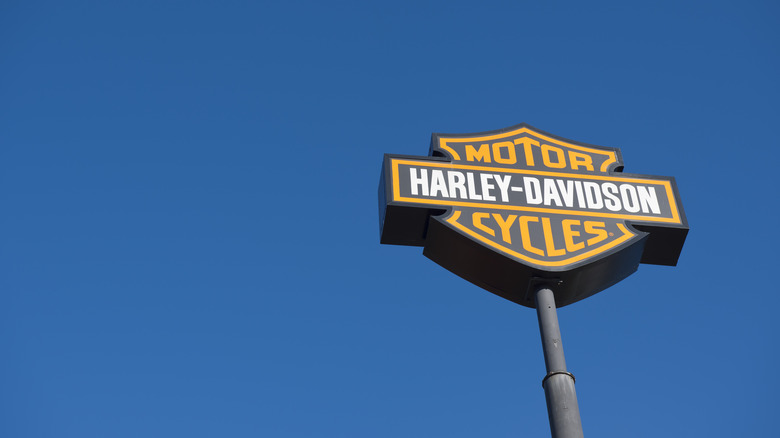
Fredrocko/Getty Images
For decades, the name Harley-Davidson has been synonymous with powerful chopper motorcycles, ruling the open highways with roaring engines and cool leather jackets. But while that may be the brand’s modern image, you’d be forgiven for forgetting that Harley-Davidson has been around for well over 100 years, having gotten its start thanks to a pair of buddies with a fondness for the mechanical.
Every great brand had to start somewhere, and for Harley-Davidson, the rip-roaring choppers we know today actually got their start as a surprisingly humble little two-wheeler, born of a coincidental trip to the theater to see the local vaudeville act. This little bike, known as the Harley-Davidson Model 1, set the stage for what would become a global superpower in the biking industry, even though it wasn’t much more than a regular bicycle with an engine strapped to it, assembled in a tiny wooden shed in Wisconsin.
The conceptualization
The company that would become Harley-Davidson was founded at the turn of the 1900s by a pair of young men named William S. Harley and Arthur Davidson. Both of these gentlemen had an interest in the automotive field, with Harley working in a bicycle factory and Davidson working as a draftsman, and the two struck up a friendship over their mutual interest. One night, in 1901, the pair visited the local vaudeville theater to take in some entertainment, where they witnessed a performer ride across a stage on an engine-powered tricycle.
Inspired by the unusual prop, Harley and Davidson attempted to apply the concept to a traditional two-wheeler. Their first prototype, the Model 0, utilized a single-cylinder engine and a belt drive. That didn’t quite get them the muscle they were looking for, so they iterated further, building a new body from scratch to fit a larger engine. The result was their new company’s first official product, the Model 1.
Fun fact: The Model 1 was completed in 1905. The vehicle commonly regarded as the first motorcycle was created in 1885 by German engineers Gottlieb Daimler and Wilhelm Maybach. So while the Model 1 wasn’t the first motorcycle ever made, Harley and Davidson only missed the proverbial start line by a couple of decades.
[Image by Library of Congress via Wikimedia Commons | Cropped and scaled]
The Harley-Davidson Model 1
The Harley-Davidson Model 1 featured a 24.74 cubic inch inlet-over-exhaust single-cylinder engine mounted to a custom-built 185-pound body alongside a single-speed belt drive. You’d be forgiven for not immediately identifying it as a Harley-Davidson motorcycle — compared to the behemoths we know today, it just looks like an ordinary bicycle with a small engine mounted to the middle. It’s only thanks to the proud Harley-Davidson logo emblazoned on the side that you know who made this plucky vehicle.
Cranked up to its top speed, the Model 1 could usually do around 40 mph, about the same as the original Ford Model T. Amusingly, the Model 1 actually still had a pedaling mechanism on the side, so if the engine wasn’t getting you enough power, you could give it a little pep with your own two legs. The very first documented instance of a public Harley-Davidson ride was in 1904 when an early version of the Model 1 took fourth place at a motorcycle race at Wisconsin State Fair Park.
[Image by Harley-Davidson Museum via Wikimedia Commons | Cropped and scaled | CC BY-SA 4.0]
Are there any Model 1s left?
After finishing the first Model 1, Harley and Davidson went into overdrive securing funding and partnerships, and in just a few years time, their motorcycles became the talk of the town in Wisconsin and Illinois, with more successes — like the famous Fat Boy — to follow.
Of course, considering this landmark in the automotive business took place over 110 years ago, it’s not especially surprising that there aren’t really any Model 1s left in the world. Remember, this was well before we had universal standards for automotive upkeep — people rode the heck out of these bikes and then just left them in the driveway, so they didn’t exactly get the best treatment. The precise number of intact Model 1s remaining to this day is unknown, but there are a few in the possession of automotive historians and collectors around the world, with some even on display in museums.
While you can’t realistically get your hands on an authentic Model 1 anymore, some companies like Heroes Motors do make surprisingly authentic replicas of the vehicle. Granted, they’re not exactly roadworthy by today’s standards, and they still cost a hefty $245,000, but it’s a drop in the bucket for a representation of one of the West’s greatest automotive achievements.